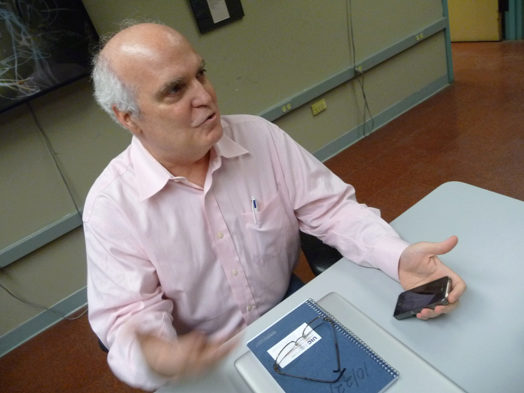Chicago virtual reality lab home to futuristic health class
February 14th, 2012
Categories: Education, Human Factors, User Groups

About
EDITOR’S NOTE: “Human Augmentics” is a new Special Topics course offered by the UIC Computer Science Department, which is co-organized by Professors Robert Kenyon and Jason Leigh. It is profiled in a recent news article by a Northwestern University Medill School journalism student.
Chicago virtual reality lab home to futuristic health class
by Thomas Owen
Feb 14, 2012
SOME EXCERPTS…
Futuristic health care is being conceptualized at the Electronic Visualization Laboratory (EVL) at the University of Illinois at Chicago. EVL uses technology that may be applied to create the futuristic settings for a new UIC class in “Human Augmentics,” the study of merging biology and technology. The course is a look into the future of rehabilitation and monitoring of health habits. It creates projects in a group setting to create prototype devices that aid or monitor a person’s health or health habits in ways that their biology may not.
The multidisciplinary course is taught in part by Professor Robert Kenyon, who has been working in the rehabilitation field for about 10 years. Kenyon is a modern-day Renaissance man whose specialties include rehabilitation, computer science and bioengineering. “After working for that long and seeing the effect of this new technology, it became clear to me that the current way of rehabilitating is slow and uncertain,” said Kenyon, who also works with the Rehabilitation Institute of Chicago. “Basically, it’s a ‘patient heal thyself.’” “I started thinking, ‘why not have the technology do it?’” he said.
The course includes students from psychology, communications, computer science, bioengineering and biology. “The thing that’s difficult is to get that group to talk to each other so that they’re not talking over each other,” Kenyon said. That way, “you come to the party with different ideas, and basically, whether you want to or not, you teach the other person. Each of them is learning, hopefully, either painfully or not, the other person’s way of thinking.”
Leigh said that there is also a market benefit for augmentics technologies. “We believe if you are able to use augmentics technology for health care, you can bring the overall cost of health care down, because you are reducing the number of visits to hospitals,” Leigh said. “If you are constantly helping people understand the ramifications of what they do, there’s a potential that you can help them avert cancer, avert diabetes, avert all of these other things.”
Joining the course was a no-brainer for some students. “I see it as a continuation of my research, where I can see how I can augment humans and persuade them to make the right choices or change their behavior by monitoring their habits,” said Victor Mateevitsi, a Ph.D. candidate at EVL. Mateevitsi is working on the “Spider Sense” project. With Mateevitsi’s work, no devices have been built yet, but ideas include vests, suits or t-shirts that can give users a “sixth-sense” about impending dangers such as bad weather, or, for someone blind, the proximity of an object.
Read the complete article
Learn more about the Human Augmentics class
Learn more about UIC’s focus in Human Augmentics